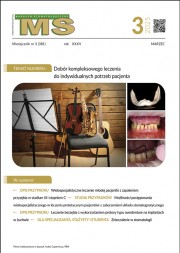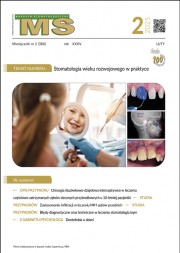Dostęp do tego artykułu jest płatny.
Zapraszamy do zakupu!
Po dokonaniu zakupu artykuł w postaci pliku PDF prześlemy bezpośrednio pod twój adres e-mail.
-
Lemos CAA, de Souza Batista VE, de Faria Almeida DA i wsp. Evaluation of cement-retained versus screw-retained implant-supported restorations for marginal bone loss: a systematic review and meta-analysis. J Prosthet Dent. 2016; 115(4): 419-427.
-
Sivolella S, Stellini E, Testori T i wsp. Splinted and unsplinted short implants in mandibles: a retrospective evaluation with 5 to 16 years of follow-up. J Periodontol. 2013; 84(4): 502-512.
-
Pjetursson BE, Brägger U, Lang NP i wsp. Comparison of survival and complication rates of tooth-supported fixed dental prostheses (FDPs) and implant-supported FDPs and single crowns (SCs). Clin Oral Implants Res. 2007; 18(Suppl 3): 97-113.
-
Manzano G, Montero J, Martín-Vallejo J i wsp. Risk factors in early implant failure: a meta-analysis. Implant Dent. 2016; 25(2): 272-280.
-
Isidor F. Influence of forces on peri-implant bone. Clin Oral Implants Res. 2006; 17(Suppl 2): 8-18.
-
Duyck J, Vandamme K. The effect of loading on peri-implant bone: A critical review of the literature. J Oral Rehabil. 2014; 41(10): 783-794.
-
Oliva J, Oliva X, Oliva JD. One-year follow-up of first consecutive 100 zirconia dental implants in humans: a comparison of 2 different rough surfaces. Int J Oral Maxillofac Implants. 2007; 22(3): 430-435.
-
Scheller H, Urgell JP, Kultje C i wsp. A 5-year multicenter study on implant-supported single crown restorations. Int J Oral Maxillofac Implants. 1998; 13(2): 212-218.
-
Wang TM, Leu LJ, Wang J i wsp. Effects of prosthesis materials and prosthesis splinting on peri-implant bone stress around implants in poor-quality bone: A numeric analysis. Int J Oral Maxillofac Implants. 2002; 17(2): 231-237.
-
Fan T, Li Y, Deng WW i wsp. Short implants (5 to 8 mm) versus longer implants (>8 mm) with sinus lifting in atrophic posterior maxilla: a meta-analysis of RCTs. Clin Implant Dent Relat Res. 2017; 19(1): 207-215.
-
Abduljabbar T, Al-Hamoudi N, Al-Sowygh ZH i wsp. Comparison of peri-implant clinical and radiographic status around short (6 mm in length) dental implants placed in cigarette-smokers and never-smokers: six-year follow-up results. Clin Implant Dent Relat Res. 2018; 20(1): 21-25.
-
Wyatt CC, Zarb GA. Treatment outcomes of patients with implant-supported fixed partial prostheses. Int J Oral Maxillofac Implants. 1998; 13(2): 204-211.
-
Artzi Z, Carmeli G, Kozlovsky A. A distinguishable observation between survival and success rate outcome of hydroxyapatite-coated implants in 5-10 years in function. Clin Oral Implants Res. 2006; 17(1): 85-93.
-
Amine M, Guelzim Y, Benfaida S i wsp. Short implants (5-8 mm) vs. long implants in augmented bone and their impact on peri-implant bone in maxilla and/or mandible: Systematic review. J Stomatol Oral Maxillofac Surg. 2019; 120(2): 133-142.
-
Friberg B, Jemt T, Lekholm U. Early failures in 4,641 consecutively placed Brånemark dental implants: A study from stage 1 surgery to the connection of completed prostheses. Int J Oral Maxillofac Implants. 1991; 6(2): 142-146.
-
Piza Pellizzer E, Cantieri de Mello C, Ferreira Santiago Jr J i wsp. Analysis of the biomechanical behavior of short implants: the photo-elasticity method. Mater Sci Eng C Mater Biol Appl. 2015; 55: 187-192.
-
Mendonça JA, Francischone CE, Senna PM i wsp. A retrospective evaluation of the survival rates of splinted and non-splinted short dental implants in posterior partially edentulous jaws. J Periodontol. 2014; 85(6): 787-794.
-
Pieri F, Aldini NN, Fini M i wsp. Preliminary 2-year report on treatment outcomes for 6-mm-long implants in posterior atrophic mandibles. Int J Prosthodont. 2012; 25(3): 279-289.
-
Qiu-Lan Li, Mian-Feng Yao, Ruo-Yan Cao i wsp. Survival Rates of Splinted and Nonsplinted Prostheses Supported by Short Dental Implants (≤8.5 mm): A Systematic Review and Meta-Analysis. J Prosthodont. 2021; 31(1): 9-21.
-
Sun HL, Huang C, Wu YR i wsp. Failure rates of short (≤ 10 mm) dental implants and factors influencing their failure: a systematic review. Int J Oral Maxillofac Implants. 2011; 26(4): 816-825.
-
Worthington H, Clarkson J, Weldon J. Priority oral health research identification for clinical decision-making. Evid Based Dent. 2015; 16(3): 69-71.
-
Ravidà A, Saleh MHA, Carreño Muriel M i wsp. Biological and Technical Complications of Splinted or Nonsplinted Dental Implants: A Decision Tree for Selection. Implant Dent. 2018; 27(1): 89-94.
-
Hauchard E, Fournier BP, Jacq R i wsp. Splinting effect on posterior implants under various loading modes: a 3D finite element analysis. Eur J Prosthodont Restor Dent. 2011; 19(3): 117-122.
-
Yilmaz B, Seidt JD, McGlumphy EA i wsp. Comparison of strains for splinted and nonsplinted screw-retained prostheses on short implants. Int J Oral Maxillofac Implants. 2011; 26(6): 1176-1182.
-
De Souza Batista VE, Verri FR, Lemos CAA i wsp. Should the restoration of adjacent implants be splinted or nonsplinted? A systematic review and meta-analysis. J Prosthet Dent. 2019; 121(1): 41-51.
-
Clelland N, Chaudhry J, Rashid RG i wsp. Split-Mouth Comparison of Splinted and Nonsplinted Prostheses on Short Implants: 3-Year Results. Int J Oral Maxillofac Implants. 2016; 31(5): 1135-1141.
-
Al Amri MD, Kellesarian SV. Crestal bone loss around adjacent dental implants restored with splinted and nonsplinted fixed restorations: a systematic literature review. J Prosthodont. 2017; 26(6): 495-501.
-
Prete BRJ, Silva MAJ, Wong BC i wsp. A pattern of peri-implantitis affecting middle implants in 3-implant splinted prostheses. Clin Adv Periodontics. 2023.
-
Goiato MC, Pellizzer EP, Freitas da Silva EV i wsp. Is the internal connection more efficient than external connection in mechanical, biological, and esthetical point of views? A systematic review. Oral Maxillofac Surg. 2015; 19(3): 229-242.
-
Vanlıoğlu B, Özkan Y, Kulak-Özkan Y. Retrospective analysis of prosthetic complications of implant-supported fixed partial dentures after an observation period of 5 to 10 years. Int J Oral Maxillofac Implants. 2013; 28(5): 1300-1304.
-
Behr M, Winklhofer C, Schreier M i wsp. Risk of chipping or facings failure of metal ceramic fixed partial prostheses – a retrospective data record analysis. Clin Oral Investig. 2012; 16(2): 401-405.
-
Abduo J, Bennani V, Waddell N i wsp. Assessing the fit of implant fixed prostheses: A critical review. Int J Oral Maxillofac Implants. 2010; 25(3): 506-515.
-
Shi JY, Xu FY, Zhuang LF i wsp. Long-term outcomes of narrow diameter implants in posterior jaws: a retrospective study with at least 8-year follow-up. Clin Oral Implants Res. 2018; 29(1): 76-81.
-
Pieri F, Aldini NN, Fini M i wsp. Immediate functional loading of dental implants supporting a bar-retained maxillary overdenture: Preliminary 12-month results. J Periodontol. 2009; 80(11): 1883-1893.
-
Van Velzen FJJ, Lang NP, Schulten EAJM i wsp. Dental floss as a possible risk for the development of peri-implant disease: An observational study of 10 cases. Clin Oral Implants Res. 2016; 27(5): 618-621.
-
Serino G, Ström C. Peri-implantitis in partially edentulous patients: Association with inadequate plaque control. Clin Oral Implants Res. 2009; 20(2): 169-174.
-
Pieri F, Forlivesi C, Caselli E i wsp. Narrow-diameter (3.0 mm) versus standard-diameter (4.0 and 4.5 mm) implants for the splinted partial fixed restoration of posterior jaws: A 5-year retrospective cohort study. J Periodontol. 2016; 88(4): 1-14.
-
Norton MR. Multiple single-tooth implant restorations in the posterior jaws: maintenance of marginal bone levels with reference to the implant-abutment microgap. Int J Oral Maxillofac Implants. 2006; 21(5): 777-784.















